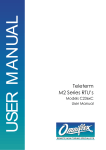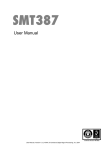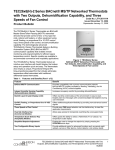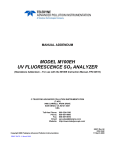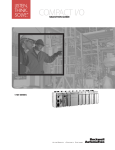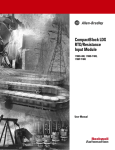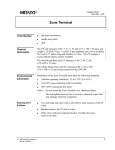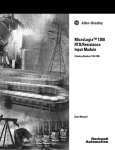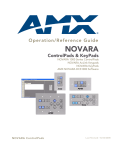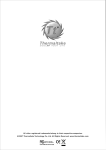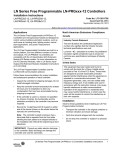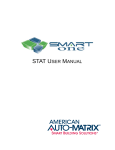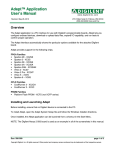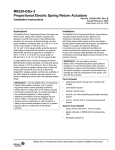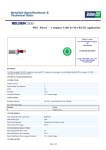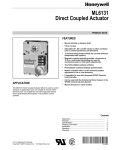Download Installation Bulletin - Johnson Controls | Product Information
Transcript
FANs 268.1, 1628.3, 977 Installation Bulletin Issue Date M100C 0600 M100C Series Actuator with Digital Control Signal Input and R81CAA-2 Interface Board I nstallation Parts Included Take the following precautions for the actuator: • proportional spring return or non-spring return actuator (R81CAA-2 electronics installed) • • five 1/4 in. female quick connect terminals • LVR27A-602 crank arm (only included with the spring return models) Do not install the actuator in atmospheres where explosive vapors or gases could be present, or environments where substances corrosive to the device’s internal components could be present. • Seal wiring entering into return air systems to prevent aspiration of corrosive air into the actuator. R81CAA-2: • top cover electronics assembly • terminal board • two No. 6-32 x 5/16 in. Phillips-head screws Tools Needed • No. 2 Phillips screwdriver • 3/16 in. (5 mm) flat-blade screwdriver • punch and hammer Precautions IMPORTANT: All M100C Series actuators are intended to control equipment under normal operating conditions. Where failure or malfunction of M100C actuators could lead to an abnormal operating condition that could cause personal injury or damage to the equipment or other property, other devices (limit or safety controls) or systems (alarm or supervisory) intended to warn of, or protect against, failure or malfunction of M100C actuators must be incorporated into and maintained as part of the control system. C ontrol Input M100C Series actuators receive and interpret digital commands from a controller for accurate positioning of the output shaft. The M100CAA-2 is a dual direct and reverse acting model replacing the M100CAA-1 (direct acting only) and M100DAA-1 (reverse acting only) models. The actuator’s travel is factory set at 90° and is field adjustable from 65 to 270°. The timing of the actuator is 38 seconds for 90° rotation and 60 seconds for 160° rotation. D irection of Rotation The actuators are factory set at the zero position and for 90° travel. The zero position is 10° Clockwise (CW) from vertical. (See Figure 2.) Spring return models always return Counterclockwise (CCW) to the zero position when power is removed. Direction of Drive Rotation Terminals CW and T1 Shorted Keyway 10° Zero Position Drive Shaft Direction of Drive Rotation Terminals CCW and T1 Shorted LOAD END Figure 1: Direction of Rotation © 2000 Johnson Controls, Inc. Part No. 34-636-70, Rev. A Code No. LIT-2681113 1 www.johnsoncontrols.com Installing Boards All reference to the direction of rotation is when viewing the load end stamped on the actuator housing as shown in Figure 1. From this view, the Counterclockwise (CCW) limit is the zero position. M ounting M100X base actuators are not provided with circuit boards. To install one, loosen the actuator’s two cover screws, remove the cover, and proceed as follows: 1. Install the terminal board by carefully placing the terminal receptacles onto the pin terminals. (See Figure 2.) Terminal Board Receptacles Actuator Follow the installation steps for the linkage kit used to couple the actuator and the controlled device. When not utilizing a damper or valve linkage kit, use four 1/4 x 1 in. bolts to mount the actuator (not included). Terminal Board Screws (2) Pin Terminals Upright mounting of the actuator is recommended. Multi-position mounting is acceptable as long as the output shaft is parallel to the floor. Locate the actuator where the shaft and wiring terminals are accessible. IMPORTANT: For installations using the CVR83A-600R Weather Cover Kit, mount the actuator in an upright position to prevent water from entering the enclosure and damaging the actuator. Make all linkage connections to the drive shaft on the load end of the actuator, rated for up to 200 lb dead weight. Limit the load on the auxiliary end to 10 lb dead weight. When mounting on a valve, mount the actuator above the horizontal plane of the valve piping to avoid damage to the actuator if the valve leaks or develops condensation. Note: Valve medium temperatures above 250°F (121°C) are acceptable only if the actuator’s maximum ambient temperature is below 105°F (41°C). R81C Installation ! 2 CAUTION: Equipment Damage Hazard. Disconnect all power supplies before removing the wiring connections and boards to avoid possible damage to the equipment. Figure 2: Installing the Terminal Board 2. Fasten the board with the No. 6-32 x 0.312 Phillips-head screws supplied. 3. Install the ribbon attached cover-mounted vertical board, carefully placing the terminal receptacles onto the two sets of pin terminals so all pins are aligned. (See Figure 3.) Terminal Receptacles Attached Cover Vertical Board Pin Terminals Receptacles Pin Terminals Figure 3: Installing the Vertical Board M100C Series Actuator with Digital Control Signal Input and R81CAA-2 Board Installation Bulletin 4. Place the bracket, supplied with the actuator, over the vertical board and fasten it in place with the captive screw. (See Figure 4.) 3. Pull the vertical board straight upward, being careful not to bend or damage the pin terminals. 4. Remove the two screws from the terminal board. 5. Grasp the receptacles and remove the terminal board by lifting upward, being careful not to bend or damage the pin terminals. Bracket Captive Screw Vertical Board W iring ! Figure 4: Installing the Bracket 5. Apply the adhesive-backed identification label provided to the actuator bracket. (See Figure 5.) Bracket M150 X GA-1 C Identification Label CAUTION: Equipment Damage Hazard. Disconnect all power supplies before wiring connections are made. Check all wiring connections before applying power to the system. Short-circuited or improperly connected wires will result in permanent damage to the equipment. Follow these procedures to wire the actuator: • Make all wiring connections using copper conductors only. Wire in accordance with the National Electrical Code and local regulations. • Use separate transformers on each M100 actuator to avoid potential miswiring or control signal problems. • Locate all splicing and excess wiring outside the actuator wiring compartment. If desired, add a standard electrical box to the actuator’s wiring compartment. (See Figure 6.) Note: The letter on the label completes the model number of the M100 actuator after R81 installation. Figure 5: Installing the Identification Label Wiring Compartment Removing Boards To remove a circuit board, loosen the cover screws and remove the actuator cover. (The old cover will be replaced by the new furnished cover.) 1. Disconnect all wiring to the terminal board. 2. Loosen the captive screw, and remove the bracket. (See Figure 4.) Figure 6: Wiring Compartment M100C Series Actuator with Digital Control Signal Input and R81CAA-2 Interface Board Installation Bulletin 3 C alibration The M100C does not require shielded cable on runs less than 50 feet (15 m). Avoid running low voltage control wiring in the same conduit as line voltage wiring, 24 VAC wiring, or other conductors that supply highly inductive loads (contactors, coils, motors, generators, etc.) Use shielded cable if the control wiring is longer than 50 feet (15 m), run in a common conduit, or located near inductive loads. Use 22 AWG, Beldfoil 8761, or an equivalent for runs up to 250 feet (76 m). For runs between 250 to 500 ft (76 to 152 m), use 18 AWG, Beldfoil 8760, or an equivalent. Connect the shield to the controller (Common) only. Do not connect the shield to any other point. To connect the wiring: Switch Settings Note: If switch settings are changed after the actuator is powered, short the BUS to the COM for a moment for the changes to take effect. Make field adjustments using the 8-position DIP switch located on the cover-mounted circuit board as shown in Figure 8. The position of these switches specifies the operating parameters as shown in Table 1. 1 2 3 4 5 6 7 8 1. Use a hammer and punch to drive out one of the access holes. O N 2. Install the conduit connector (not provided) to the actuator, and secure it using the conduit nut provided with the connector. IMPORTANT: Proper wiring polarity of the COM and BUS connections must be maintained when multiple actuators are wired in parallel. CW CC CCW BUS Tape off the shield end at the actuator. Connect the shield only at the controller. Level 1 Bus or Zone Bus from the Controller Switch Number 24 VAC Power Supply Figure 7: Typical Single Unit Wiring Diagram 4. Connect isolated 24 VAC to Terminals T1 and T2. Figure 7 shows a wiring configuration. Refer to the M100C Series Actuator with Digital Control Signal R81CAA-2 Interface Board Application Note (LIT-2681132 in FAN 268.1, 977, or 1628.3) for more specific wiring information. 4 ST M T1 2 Table 1: Switch Settings T1 T2 BU Figure 8: Digital Circuit Board 3. Connect the controller to COM and BUS located in the wiring compartment. (See Figure 7.) M100C COM CW W CO * On Function Off Function 1 Slave Master 2 S-curve Linear 3 Reverse Acting Direct Acting 4 Zone Bus L1 Bus 5* Address Selection Address Selection 6* Address Selection Address Selection 7* Address Selection Address Selection 8* Address Selection Address Selection Refer to Address Selection section for complete address selection options. Master/Slave for Zone Bus Set Switch 1 to the Off position for master operation. The Zone Bus does not use the On position, which is the slave function. M100C Series Actuator with Digital Control Signal Input and R81CAA-2 Board Installation Bulletin Master/Slave for DSC1000 Level 1 Bus Linear/S-Curve Flow Characteristics Both master and slave actuators receive commands from the controller, but only the master actuator has continuous two way communication with the controller. Slave actuators send response messages back to the controller only if an error occurs at the slave. (See the Address Selection section.) The greatest amount of flow occurs in the early portion of travel for valves and dampers with non-linear flow characteristics. The S-curve switch setting allows the actuator to respond in a non-linear manner. Use Switch 1 to select whether the actuator will respond as a master or slave. Position the switch to Off to set the actuator for master operation, and position it to On for slave operation. Percent Flow (CW) 100% Relative to the input command, actuator travel is smaller during the initial 20%, increases during the mid 60%, and decreases during the final 20% of the command. Use Switch 2 to select the response. Position Switch 2 to On to set the actuator for S-curve operation. (See Figure 9 for characteristics.) Actuator Rotation (CW) 100% 80% 80% Actuator 60% Rotation Actuator 60% Rotation 40% 40% Direct Acting 20% Reverse Acting 20% 0% (CCW) 0% 20% 40% 60% 80% 100% Controller Command 0% (CCW) 0% 20% 40% 60% 80% 100% Controller Command Figure 9: Linear Characteristics Position Switch 2 to On to set the actuator for S-curve operation. (See Figure 10 for characteristics.) (CW) 100% Percent Flow 80% Command = 90% Actuator Rotation 80% 0% (CCW) 0% (CW) 100% 20% Command = 90% Actuator Rotation 80% Direct Acting Actuator 60% Rotation 40% 20% Actuator Rotation Actuator Rotation Reverse Acting 60% 40% 20% 20% Command = 10% Actuator Rotation 20% 40% 60% 80% 100% Controller Command 0% (CCW) 0% 80% Command = 10% Actuator Rotation 20% 40% 60% 80% Controller Command 100% Figure 10: S-Curve Characteristics M100C Series Actuator with Digital Control Signal Input and R81CAA-2 Interface Board Installation Bulletin 5 Direct/Reverse Acting The M100C is factory set for DA. A 0 to 100% command will cause the load end output shaft to rotate fully CCW at 0% and fully CW at 100%. Switch 3 is set to Off. ! When set for RA, a 0 to 100% command will cause the load end output shaft to rotate fully CCW at 100% and fully CW at 0%. Change Switch 3 to On. CAUTION: Equipment Damage Hazard. The phone jack connector on the terminal board is for single-point connection of the HVAC PRO configuration tool. Do not connect any other device at the phone jack. This could result in damage to the equipment or wiring. L1/Zone Bus C500 Controllers use the L1 Bus. Application Specific Controllers (ASC) use the Zone Bus. Set Switch 4 to the Off position to allow the actuator to communicate with a C500 and to On to communicate with an ASC. Note: Refer to M100C Series Actuator with R81CAA-2 Interface Board for C500 Digital Controllers Application Note (LIT-2681132 in FAN 268.1, 977, or 1628.3). O4 N 5 6 O4 N 5 6 Note: Refer to M100C Series Actuator with R81CAA-2 Interface Board for C500 Digital Controllers Application Note (LIT-2681132 in FAN 268.1, 977, or 1628.3). Zone Bus Controller Address Selection 7 8 4 5 6 7 8 O4 N 5 6 7 8 O4 N O N 5 6 7 8 O4 4 Address 22 5 6 7 8 5 6 7 8 N Address 27 Figure 11: Address Switch Settings for the Zone Bus Table 2: Switch Values for the Zone Bus Switch Number On Value Off Value 5 0 — 6 0 4 7 0 2 8 0 1 Note: Switch 5 must be On and an additional value of 20 added to the total of the switch settings for selection of the Zone Bus. For example: To select Zone Bus Address 25, set Switches 6 and 8 to Off and Switches 5 and 7 to On (25 = 0 + 4 + 0 + 1 from the switch settings and +20 because of Zone Bus selection). Select any Zone Bus address between 20 and 27 using the switches. The addresses used by the ASC are 20 through 27. Make the address assignment during HVAC PRO™ configuration for analog outputs. (See Figure 11.) Refer to the HVAC PRO User’s Manual (FAN 637.5 or 1637.5) for details. 6 7 8 Address 25 Address 24 5 6 Address 26 1. Set all units as the master with the same address when used with an ASC. 2. Set one unit as the master, and the remaining units as slaves with the same address when used with a C500. 4 Address 21 Address 23 Address Selection Configure multiple actuators with a separate address when each one performs a different function. When all the actuators perform the same function: O N Address 20 O N The controlled device will respond only to a command preceded by its assigned address code number. The positioning of Switches 5, 6, 7, and 8 provides address information to the controller. The switches are each positioned so that the sum of their individual values provides the desired address value. 7 8 M100C Series Actuator with Digital Control Signal Input and R81CAA-2 Board Installation Bulletin Travel Adjustment The rotation range of M100C is adjustable from 65 to 270°. The controller sends position commands to the actuator ranging from 0 to 100%. The actuator responds to these commands only over its selected range of travel. (See Figure 12.) 100% (CW) Reverse Acting Note: Manually driving the actuator will override the controller's command. Be sure to disconnect any control wiring before manually driving the actuator. 1. Remove all control wires, and make sure the travel adjustment potentiometer is set fully CCW. Actuator Rotation 2. Apply 24 VAC between T1 and T2. 3. Jumper Terminals COM and CW to drive the actuator to the full CW position. Direct Acting (CCW) 0% 0% Use the following procedures to make the adjustments, or refer to the appropriate valve or damper linkage literature. Controller Command 100% Figure 12: Full Range Rotation For example: If a DA actuator has its travel set at 120°, a 50% command from the controller would position the actuator at 60° of rotation. A 100% command would position the actuator at 120° of rotation. 4. Slowly rotate the travel adjustment potentiometer CW to increase rotation until the corresponding valve or damper is in the desired position. 5. Move the jumper from Terminal CW to Terminal CCW to allow the actuator to return to the full CCW position. 6. Make sure the power is off, and connect the control wires. For RA actuators with a travel set at 120° rotation, the 50% command positions the actuator at 60° rotation, and a command of 100% positions the actuator at 0° of rotation. The travel adjustment potentiometer mounted on the terminal board enables positioning of the M100 actuator within the range of 65 and 270° rotation. Changing the travel adjustment affects the CW rotation limit. Turning the adjustment CW increases the total travel, and turning it CCW reduces it. M100C Series Actuator with Digital Control Signal Input and R81CAA-2 Interface Board Installation Bulletin 7 T roubleshooting A dditional Information After installation and wiring are complete, make system settings and apply power. Cycle the actuator using the controller after assembling the linkage and actuator to the valve or damper. See Table 3 for accessories, and contact the nearest Johnson Controls representative. Refer to Table 4 for product specifications. 8 M100C Series Actuator with Digital Control Signal Input and R81CAA-2 Board Installation Bulletin Table 3: Accessories Product Code Number Description Y68AA-1 Transformer, 120/24 VAC, 40 VA, 60 Hz, Class 2 Y68DA-1 Transformer, 240/24 VAC, 40 VA, 60 Hz, Class 2 Y68HA-1 Transformer, 24/24 VAC, 40 VA, 60 Hz, Class 2 S91DJ-1 Auxiliary switch kit with one Single-Pole, Double-Throw (SPDT) switch S91EJ-1 Auxiliary switch kit with two SPDT switches S91PT-1 Auxiliary potentiometer kit, 1000 ohm, 1/3 watt CVR83A-600R Weather cover kit Y20DAA-2 Mounts the actuator to the top of a duct or any flat surface. Contains the LVR27A-602, LVR27A-600, ROD16-3, and SWL10A-603Y (2). Y20DAB-2 Mounts the actuator to the side of a duct or wall. Contains all items in the Y20DAA-2 plus one BKT22A-602. Y20EBA-1 Valve linkage kit for mounting Honeywell® valves with 1/4-28 stem connection to M120 or M130 actuators Y20EBA-2 Valve linkage kit for mounting Honeywell valves with 1/4-28 stem connection to M150 actuators Y20EBA-3 Valve linkage kit for mounting Barber-Colman® valves with 1/4-28 stem connection to M120 or M130 actuators Y20EBA-4 Valve linkage kit for mounting Barber-Colman valves with 1/4-28 stem connection to M150 actuators Y20EBD-1 Linkage kit for M120 or M130 actuators and 1-1/4 in. (DN 32) valves, produces 75 lb (334 N) seating force Y20EBD-2 Linkage kit for M140 actuators and 1-1/4 in. (DN 32) valves, produces 150 lb (607 N) seating force Y20EBD-3 Linkage kit for M150 actuators and 1-1/4 in. (DN 32) valves, produces 270 lb (1202 N) seating force Y20EBD-5 Linkage kit for M110 actuators and 1-1/4 in. (DN 32) valves, produces 40 lb (178 N) seating force Y20EBD-6 Linkage kit for M120 or M130 actuators and 1-1/4 in. (DN 32) valves, produces 100 lb (449 N) seating force Y20EBE-1 Coupling adaptor to convert valves with a 5/16 in. stem and a hold down nut for Johnson Controls 1/2 to 3 in. valves manufactured prior to March 1969. Y20EBE-2 Stem adaptor and centerpiece collar to adapt VT Series valves with slotted stems. (Y20EBD-5 also required.) Y20EBE-3 Hold down nut for cast iron and VB Series 2-1/2 to 4 in. valves and yoke nut for Barber-Colman 1/2 to 2 in. valves Y20EBE-4* Stem connector for Barber-Colman 2-1/2 to 4 in. valves, 5 per package. (Use with Y20EBD-3 or -6.) Y20EBE-11 Valve Linkage Adaptor Kit for VG7000 valves. (Y20EBD Series kit also required.) VG7000-M110 Mounting Kit for M110 actuator and 1/2 through 2 in. (DN15 through DN50) valves VG7000-M130 Mounting Kit for M130 actuator and 1/2 through 2 in. (DN15 through DN50) valves VG7000-M140 Mounting Kit for M140 actuator and 1/2 through 2 in. (DN15 through DN50) valves VG7000-M150 Mounting Kit for M150 actuator and 1/2 through 2 in. (DN15 through DN50) valves Y20DFC-1 Damper linkage kit for mounting the actuator to CD-1300 dampers only (includes a universal mounting bracket for inside or outside damper frame mounting) M100C Series Actuator with Digital Control Signal Input and R81CAA-2 Interface Board Installation Bulletin 9 Table 4: Specifications Product M100C Series Actuator with Digital Control Signal Input R81CAA-2 Interface Board Power Requirements 24 VAC, Class 2, (20 to 30 VAC) at 50/60 Hz; 25 VA spring return, 20 VA non-spring return Input Signal Digital from Johnson Controls application specific controllers or the DSC1000 Input Signal Adjustments Direct Acting (DA) or Reverse Acting (RA), Master or Slave, L1 Bus or Zone Bus, Linear or S-curve flow characteristics, Address Selection: 10 through 27 Factory Settings: DA, Master, Linear, L1 Bus, Address 27 Mechanical Connection 3/8 in. (9.5 mm) square shaft, both ends Maximum dead weight on output shaft: 200 lb (91 kg), load end; 10 lb (4.5 kg), auxiliary end Mechanical Output M110 M120 M130 M140 M150 Running Torque: 25 lb∙in (2.8 N∙m) spring return 35 lb∙in (4.0 N∙m) 50 lb∙in (5.6 N∙m) spring return 75 lb∙in (8.5 N∙m) 150 lb∙in (17 N∙m) Breakaway and Stall (minimum): 100 lb∙in (11 N∙m) 70 lb∙in (7.9 N∙m) 200 lb∙in (23 N∙m) 150 lb∙in (17 N∙m) 300 lb∙in (34 N∙m) Rotation Range Fixed zero, adjustable full travel 65 to 270°; factory set at 90° full travel Rotation Timing (at Rated Load) 60 seconds for 160° travel nominal, 60 Hz 38 seconds for 90° travel nominal, 60 Hz 75 seconds for 90° spring return Cycle Life M110 and M130 spring return models: 150,000 cycles at rated load M120, M140 and M150 non-spring return models: 200,000 cycles at rated load Electrical Connection 1/4 in. quick-connect spade terminals Action CW rotation on 0 to 100% command (DA) and CCW rotation on 0 to 100% command (RA); factory set for DA Ambient Operating Conditions Non-spring Return: Spring Return: Ambient Storage Conditions -40 to 140°F (-40 to 60°C), 90% RH Enclosure NEMA 2, IP32 Dimensions (H x W x D) Spring Return: Non-spring Return: 6.23 x 5.64 x 7.68 in. (158 x 143 x 195 mm) 6.23 x 5.64 x 4.94 in. (158 x 143 x 125 mm) Shipping Weight Spring Return: 9 lb (4.1 kg) Agency Compliance UL: UL 916 Listed, File E107041, CCN PAZX UL 873 Recognized, File E27734, CCN XAPX2 EU Directive Compliance M100C: -40 to 125°F (-40 to 52°C), 90% RH, 25% duty cycle -35 to 125°F (-37 to 52°C), 90% RH, 25% duty cycle Non-spring Return: 6.5 lb (2.9 kg) CSA: M100C: C22.2 No. 24 Certified, File LR948, Class 4813 02 M100X and R81: No UL Listing or CSA Certification 89/336/EEC (CE Mark) The performance specifications are nominal and conform to acceptable industry standards. For application at conditions beyond these specifications, consult the local Johnson Controls office. Johnson Controls, Inc. shall not be liable for damages resulting from misapplication or misuse of its products. 10 M100C Series Actuator with Digital Control Signal Input and R81CAA-2 Board Installation Bulletin Notes M100C Series Actuator with Digital Control Signal Input and R81CAA-2 Interface Board Installation Bulletin 11 Notes Controls Group 507 E. Michigan Street P.O. Box 423 Milwaukee, WI 53201 12 Printed in U.S.A. www.johnsoncontrols.com M100C Series Actuator with Digital Control Signal Input and R81CAA-2 Board Installation Bulletin













